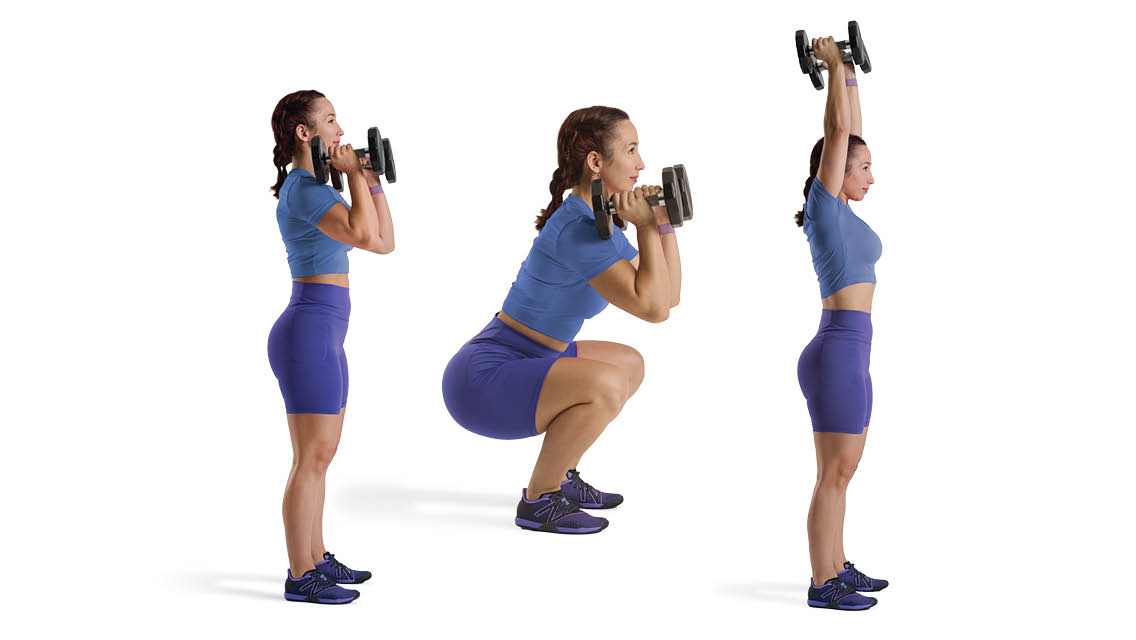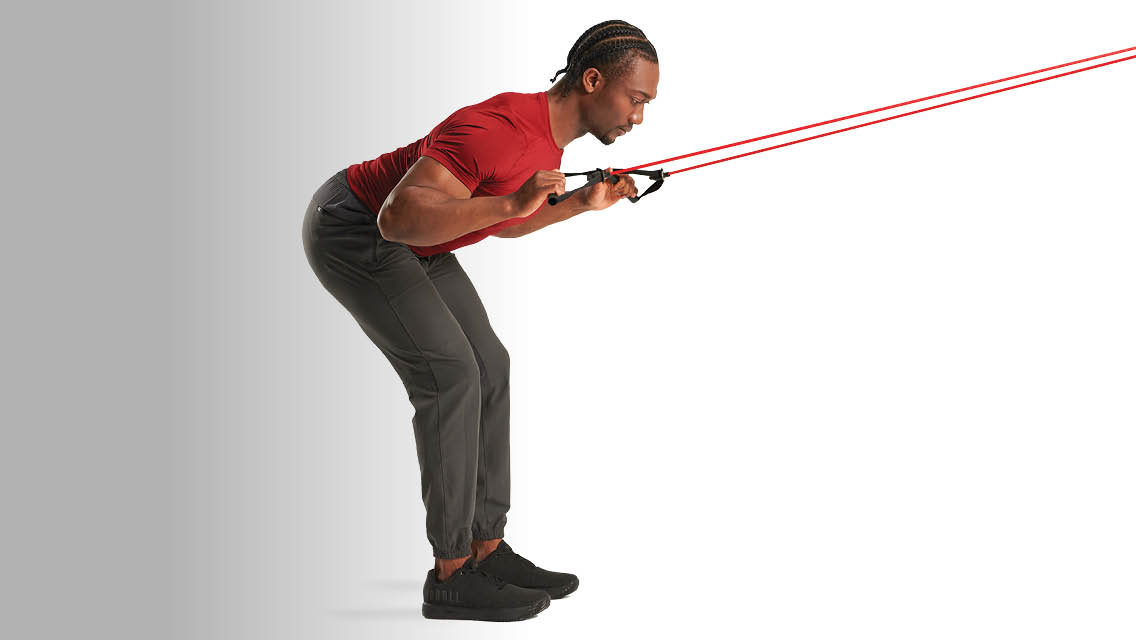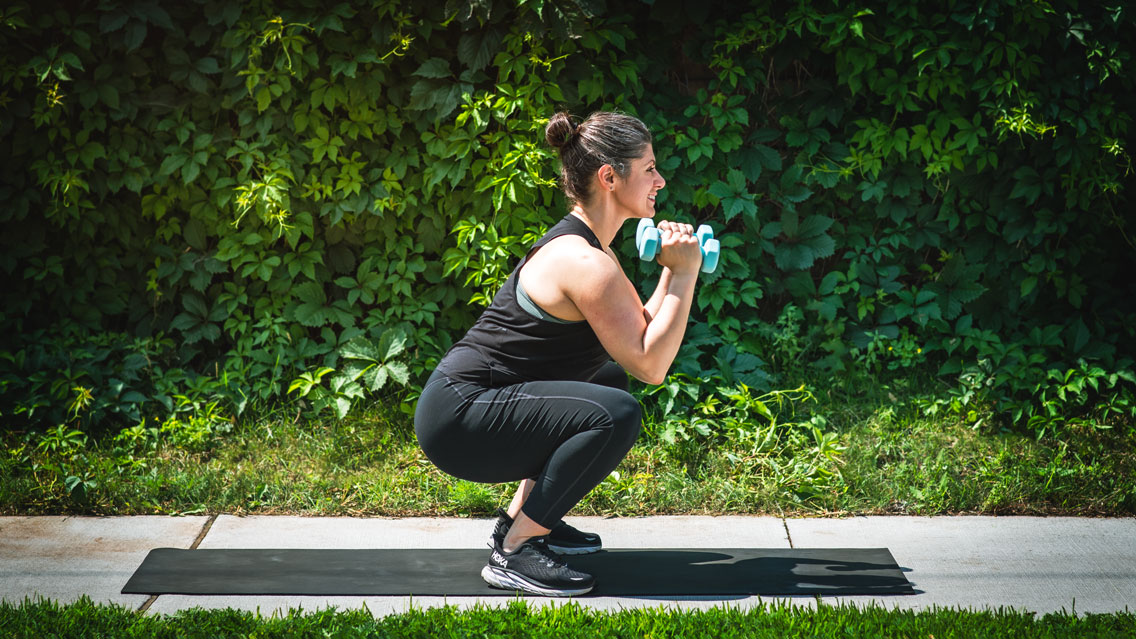The thruster combines two moves — the front squat and the push press — into a single exercise that’s notable for building strength and power; improving movement efficiency, coordination, and balance; and boosting your cardio capacity.
Like burpees, thrusters are one of the more polarizing compound exercises. Whether you love them or hate them, these tips can help you get the most out of this movement.
Hone your form.
A common pitfall when you’re doing thrusters is to attempt the move without mastering its individual parts. Make sure that you are comfortable with the mechanics of a front squat and push press before piecing them together.
Move with control.
Because thrusters are a conditioning challenge, it’s tempting to assume a breakneck pace. Not only is this exhausting, but it can also compromise your form.
Stay in control, taking care to hit each beat at the bottom of the squat and to complete a full extension at the top of the press. As you become more proficient, you can speed up the movement while staying mindful of your form and range of motion.
Keep the motion fluid.
Yes, you want to reach full range of motion at the bottom and the top of the move, but don’t get stuck. Avoid lingering at the bottom of the squat or top of the press or stopping midway through the move. Take advantage of momentum to maintain a fluid down-and-up motion.
Don’t overload the weight.
If you’re new to thrusters, start with light weights — or no weight at all, keeping your fingertips on your shoulders. As you build strength and comfort, increase the load.
Remember to breathe.
Inhale through your nose as you squat down. Exhale through your nose or mouth as you stand and press the weights overhead. Do not hold your breath.
Instructions
- Stand holding your weight of choice — a pair of dumbbells, kettlebells, or a barbell — at shoulder height with feet at about hip width.
- Keeping your chest up and your spine in a neutral position, squat down as far as you comfortably can.
- Reverse the move, forcefully pressing the weight overhead as you rise. Fully extend through your arms, hips, and knees.
- Lower the weight to shoulder height with control, and immediately flow into the squat position to repeat the move.
Cues:
- Core: Brace your core to maintain an upright chest position.
- Back: Avoid slumping or overarching your spine.
- Bottom of squat: Lower down until your thighs are parallel (or below parallel) to the floor.
- Top of press: Squeeze your glutes at the top of the press.
- Feet: Keep your heels down throughout the movement.
Variations of the Thruster
Body Weight Thruster
Full Instructions
- Stand with feet at about hip width. Place your fingertips on your shoulders and raise your elbows to shoulder height, if your mobility allows.
- Reverse the move, powerfully extending your arms straight overhead as you rise.
- Keeping your chest up, elbows raised, and spine in a neutral position, squat down as far as you comfortably can.
- Lower your fingertips to your shoulders and repeat.
Single-Arm Thruster
Full Instructions
- Stand with feet at about hip width. Hold a single dumbbell at shoulder height with one hand. Extend the opposite arm beside you at a 45-degree angle, actively reaching away.
- Keeping your chest up and your spine in a neutral position, squat down as far as you comfortably can.
- Reverse the move, forcefully pressing the dumbbell overhead as you rise.
- Lower the dumbbell to shoulder height with control. Repeat for the desired number of repetitions.
- Switch sides and repeat.
Dumbbell Thruster
Full Instructions
- Stand with feet at about hip width. Hold a single dumbbell at shoulder height with one hand. Extend the opposite arm beside you at a 45-degree angle, actively reaching away.
- Keeping your chest up and your spine in a neutral position, squat down as far as you comfortably can.
- Reverse the move, forcefully pressing the dumbbell overhead as you rise.
- Lower the dumbbell to shoulder height with control. Repeat for the desired number of repetitions.
- Switch sides and repeat.
Kettlebell Thruster
Full Instructions
- Stand with feet at about hip width. Grasp a kettlebell in either one hand or both in a front rack position with the weight(s) at shoulder height. Make sure your wrists are straight and elbows are below your wrists, as your unique anatomy allows.
- Keeping your chest up and your spine in a neutral position, squat down as far as you comfortably can.
- Reverse the move, forcefully pressing the kettlebells straight overhead as you rise.
- Lower the weights to shoulder height with control, and repeat.
Barbell Thruster
Full Instructions
- Stand with feet at about hip width. Grasp a barbell with a double-overhand grip and raise the weight to a front rack position. Maintain a loose grip on the bar and make sure most of the weight is supported on your shoulders. The backs of your arms should be parallel to the floor and your elbows should be pointing straight ahead like headlights.
- Keeping your chest up and your spine in a neutral position — and maintaining the elbows-up position — squat down as far as you comfortably can.
- Reverse the move, forcefully pressing the barbell overhead as you rise.
- Lower the dumbbells to shoulder height with control, and repeat.
This article originally appeared as “The Thruster” in the July/August 2024 issue of Experience Life.





This Post Has 0 Comments